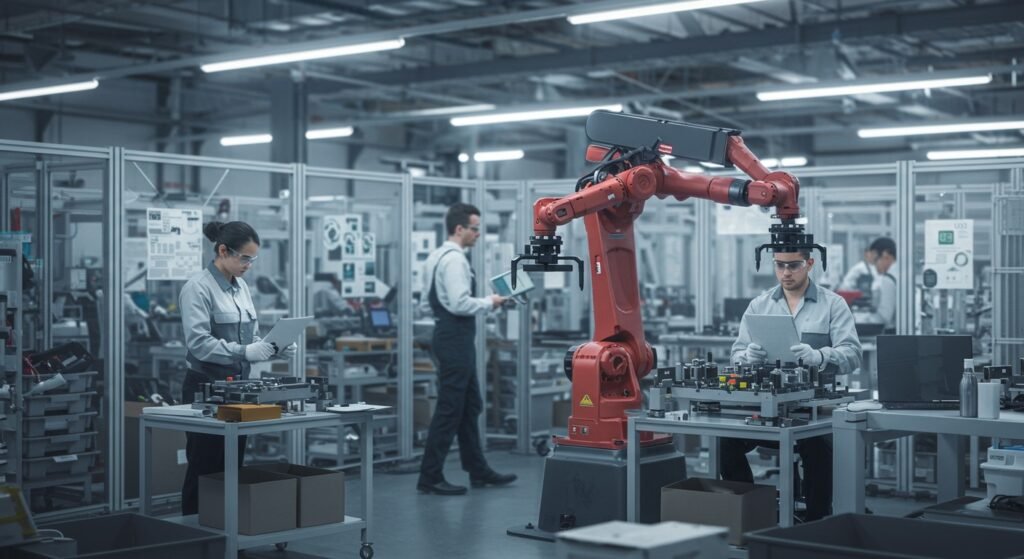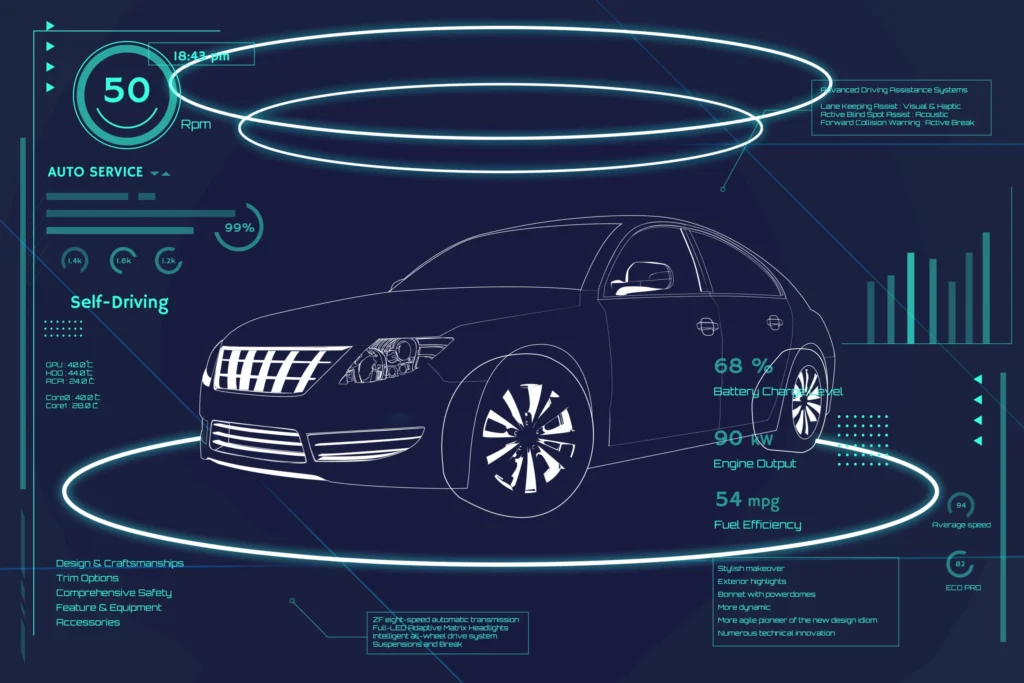The manufacturing landscape is undergoing its next significant transformation, evolving from Industry 4.0’s focus on connectivity and data to Industry 5.0’s emphasis on human-centricity, sustainability, and resilience. At the heart of this paradigm shift are cobots, or collaborative robots, which are redefining the interaction between humans and machines. These intelligent assistants are not just tools for efficiency; they are integral partners designed to enhance human capabilities, fostering a harmonious and productive work environment. This article delves into the indispensable role that cobots play in guiding industries towards a more sustainable, personalized, and human-focused future.
Table of Contents
- What is Industry 5.0?
- The Rise of Cobots: Bridging the Gap
- How Cobots Facilitate Industry 5.0 Goals
- Challenges and Future Outlook
- Conclusion
What is Industry 5.0?
Industry 5.0 represents a new vision for industrial production, moving beyond merely optimizing efficiency and productivity through automation. While Industry 4.0 was largely characterized by digitalization, interconnected systems, and the Internet of Things (IoT), Industry 5.0 aims to bring the human touch back to the factory floor. It envisions a future where humans and machines work together in perfect synergy, leveraging technology not just for economic gain, but also for societal and environmental benefits. Key pillars include human-centricity, resilience, and sustainability, positioning technology as a means to achieve a better quality of life and a healthier planet.
The Rise of Cobots: Bridging the Gap
The transition to Industry 5.0 would be incomplete without understanding the transformative impact of cobots. These are not the traditional, caged industrial robots of the past. Instead, cobots are designed from the ground up to operate safely alongside human workers without the need for extensive safety guarding, making them ideal partners in a human-centric manufacturing environment. Their emergence marks a significant evolution in automation, moving from full automation to collaborative automation, where the strengths of both humans and machines are maximized.
Defining Collaborative Robots
Collaborative robots, or cobots, are a specific type of robot designed to interact with humans in a shared workspace or work on shared tasks. Unlike conventional industrial robots that are often large, fast, and require strict separation from human operators for safety reasons, cobots are typically smaller, lighter, and equipped with advanced safety features. These include force and torque sensors, speed and separation monitoring, and power and force limiting capabilities, allowing them to detect and react to human presence, preventing collisions and ensuring a safe working environment.
Key Characteristics of Cobots
Several features distinguish cobots and make them particularly suitable for Industry 5.0:
- Safety: Designed to work without fences, often incorporating sensors for collision detection.
- Ease of Programming: Many cobots can be “taught” by demonstrating tasks, making them accessible to non-expert users.
- Flexibility: Easily redeployed for different tasks, crucial for adaptable manufacturing.
- Compact Size: Can fit into existing production lines without major reconfigurations.
- Cost-Effectiveness: Generally have lower upfront costs and faster ROI compared to traditional robots.
How Cobots Facilitate Industry 5.0 Goals
Cobots are not just tools; they are enablers of the Industry 5.0 vision, directly contributing to its core principles.
Enhancing Human-Robot Collaboration
The very essence of Industry 5.0 is the synergistic collaboration between humans and smart machines. Cobots excel here, taking over repetitive, strenuous, or hazardous tasks, thereby freeing human workers to focus on activities requiring creativity, problem-solving, and critical thinking. This collaboration leads to increased productivity, improved product quality, and a more engaging work experience. Imagine a human worker assembling a complex product while a cobot precisely holds parts or applies adhesive – a perfect division of labor that maximizes both speed and accuracy.
Boosting Personalization and Customization
One of Industry 5.0’s goals is to meet individual customer needs through hyper-personalization. Cobots, with their inherent flexibility and ease of reprogramming, are perfectly suited for low-volume, high-mix production environments. They can be quickly reconfigured to handle variations in product designs, allowing manufacturers to offer a wide array of customized products without significant retooling costs. This agility is vital for responding to dynamic market demands and consumer preferences.
Improving Worker Well-being and Safety
Prioritizing worker well-being is a cornerstone of Industry 5.0. Cobots significantly contribute to this by taking on ergonomically challenging tasks such as heavy lifting, repetitive motions that can lead to musculoskeletal disorders, or working in hazardous environments. This reduces physical strain on workers, minimizes the risk of injury, and creates a safer, healthier workplace. By offloading monotonous or dangerous jobs, cobots elevate the quality of human work, allowing employees to engage in more fulfilling and higher-value activities. You can learn more about the safety benefits of cobots.
Driving Sustainability and Efficiency
Sustainability is another critical aspect of Industry 5.0. Cobots can contribute by optimizing resource usage, reducing waste, and improving energy efficiency in production processes. Their precise movements and adaptive capabilities can minimize errors and rework, leading to less material consumption. Furthermore, by enabling more efficient production cycles, cobots can help companies achieve their sustainability goals while maintaining competitiveness. For more insights into sustainable manufacturing, consider exploring topics on sustainable manufacturing practices within our site.
Here’s a comparison highlighting the differences between traditional industrial robots and cobots:
| Feature | Traditional Industrial Robots | Cobots (Collaborative Robots) |
|---|---|---|
| Workspace | Isolated, caged areas | Shared workspace with humans |
| Safety | High speed/force, requires barriers | Built-in safety sensors, force limiting |
| Programming | Complex, often requires specialists | Intuitive, often ‘hand-guiding’ or tablet-based |
| Flexibility | Less flexible, fixed tasks | Highly flexible, easily redeployable |
| Application | High volume, repetitive tasks | Variable tasks, human-robot collaboration |
| Cost | Higher initial investment | Lower initial investment |
Challenges and Future Outlook
While the benefits are clear, the widespread adoption of cobots in Industry 5.0 faces certain challenges. These include the initial investment costs, the need for worker training to adapt to collaborative environments, and the integration of diverse robotic systems into existing infrastructure. Data security and ethical considerations regarding human-robot interaction also require careful attention. However, ongoing advancements in AI, machine learning, and sensor technology are continuously making cobots more intelligent, safer, and easier to integrate.
The future of manufacturing with cobots is promising. As these collaborative assistants become even more sophisticated, they will unlock new levels of customization, efficiency, and human empowerment. They will enable a future where manufacturing is not just about producing goods, but about creating value in a way that respects human dignity, environmental limits, and societal well-being. The continuous evolution of cobots will be instrumental in fully realizing the ambitious vision of Industry 5.0.
Conclusion
The journey towards Industry 5.0 is fundamentally about striking a new balance between technological advancement and human values. Collaborative robots, or cobots, are pivotal to this transition, acting as catalysts for a manufacturing ecosystem where efficiency, sustainability, and human well-being are not mutually exclusive but deeply integrated. By enabling seamless human-robot collaboration, boosting personalization, enhancing worker safety, and driving sustainable practices, cobots are not just shaping the factories of tomorrow; they are defining a more ethical and resilient future for industrial production.


